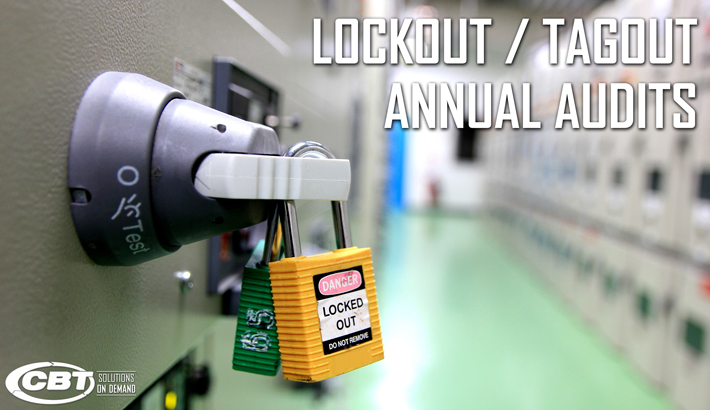
Lockout/tagout annual audits are essential for maintaining a functional, compliant program. After all, it’s not enough to create lockout procedures and never review them again. It’s not enough to train and test employees just once. And it’s not enough to assume your lockout/tagout (LOTO) program is in good shape. The fact is, it’s a best practice to revisit LOTO procedures, employee training and the overall LOTO program and policy at least once a year.
Oh, and the U.S. Occupational Health and Safety Administration (OSHA) requires it. Without an annual inspection, companies are exposed to potential OSHA violations and other safety issues.
Audits are just one of the five key components of a comprehensive LOTO program – along with equipment-specific procedures, employee training, a corporate policy, and adequate devices. However, annual auditing crosses over into half of those components: procedures and authorized employees. This illustrates the interconnectedness of these components as part of any LOTO program.
How to Conduct LOTO Audits
The audit process allows safety managers and supervisors to take a step back and examine the lockout/tagout program as a whole. Lockout/tagout-related audits provide a chance for the entire program to be reviewed for gaps, deficiencies, and flaws.
Throughout the course of any given year, a manufacturer will install new equipment or machines, perform modifications to existing equipment, and change energy sources and devices. Corrections to procedures, training and policy should be made as those changes are introduced. But with an audit, you can dive deeper to double-check that changes were made correctly, to fix any issues that may have been overlooked, and to verify that your program is up-to-date.
Procedure Audits:
OSHA requires all lockout/tagout procedures to be reviewed at least once per year. While this might seem excessive, especially for large plants, keep in mind that the number of machine modifications that occur in a year’s time averages up to 15% in most industries. And that doesn’t account for new equipment that might be installed during the year. The annual audit helps confirm all machines that need one have an updated, written procedure. For older, existing procedures, review the accuracy of information about energy sources, valves or electrical disconnects, energy source lockout/isolation, devices and pictures. For printed procedures posted on the machine, are they hanging up and in good condition? If not, they may need to be reprinted. This is also a good opportunity for clean-up of digital files. Make sure the correct version is being used and that old files are identified and placed in separate folders.
Authorized Employee Audits:
During the annual audit, it is also necessary to observe a respective sampling of authorized employees actually performing lockout/tagout to confirm they are following the procedures correctly. “Authorized employees” are those who have completed LOTO training and whose job it is to conduct the service and/or maintenance of equipment as needed. The auditor should have each employee lockout a machine, being sure to check: that the employee knew where to locate a copy of the written procedure, that the correct shutdown steps were followed when locking out the machine, that the employee used the correct devices, that the correct steps were followed to confirm energy sources were locked out and the machine reached a zero-energy state. These audits are important to gain an understanding of the authorized employees’ grasp of their lockout/tagout duties. If necessary, retraining may need to occur. If there appears to be a systemic issue with the majority of employees, it may be a good idea to review initial training techniques and potentially update the entire training program.
LOTO Program Audit:
After procedures and authorized employees have been audited, manufacturers should review the company energy control program and written policy. Make sure LOTO-related roles and responsibilities are clearly outlined and that special circumstances such as group lockout and working with contractors are included. Evaluate the overall effectiveness of your LOTO program by examining the health of your safety culture, employee understanding of the importance of lockout/tagout, time pressures that may risk employee safety, and ways to incentivize safety.
It’s true that auditing can be complicated, particularly in large plants. But from time-saving software that captures and provides the data and proof OSHA needs, to outsourcing some or all of the process to LOTO professionals, there are ways to achieve compliance.
Tips for Success
If an annual audit seems overwhelming, you’re not alone in the feeling. But preparing for and conducting audits doesn’t have to be a drain on time and resources. Here are some tips to help make the process go smoother.
- Try breaking the annual audit into a quarterly task, auditing 25% of the procedures each quarter.
- Divide up responsibility between multiple auditors or have each department responsible for auditing their own equipment.
- Consider outsourcing the audit and/or policy review.
- Have supervisors audit their authorized employees throughout the year, when they are already performing lockout; keep a spreadsheet to know who’s been audited so far.
- Use annual PMs as a time to review the lockout/tagout procedure; track audits throughout the year.
- Invest in lockout/tagout auditing software, like ScanESC™, to help manage and document the process.
- Create a system for employees to report machine modifications throughout the year, so procedures can be updated in real time.
- Consult this handy auditing checklist to help keep you on track.
Article originally posted on Rockwell Automation Journal









